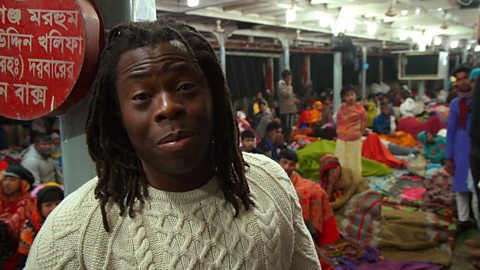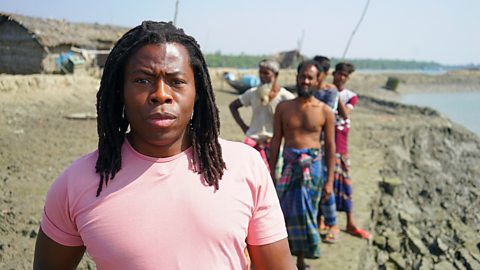Ade Adepitan is in a forest region of Bhutan to find out how planting trees is a simple and cost-effective way of countering climate change.
ADE: Hi, Iβm Ade and Iβm in Bhutan and Iβm about to meet a man whoβs doing everything he can to fight climate change in a very simple but effective way.
[MAP SHOWING LOCATION OF BHUTAN]
I think weβre going to need some teamwork here.
SONAM: Okay.
ADE: Sonam Phuntsho has spent most of his life planting trees by hand. He used to be paid to it as a forest ranger but even now in retirement when most people would be putting their feet up, heβs still out here planting on any bare land he can find.
ADE: Ah, these are the trees.
SONAM: Yes, sir.
ADE: The seedlings.
SONAM: And now I will load, sir, on the basket, sir.
ADE: Ok. And youβre gonna put it on your back.
SONAM: Yes, sir.
ADE: Which way do we go?
SONAM: This way, same way sir, weβll go. We have to step down also a little bit, sir, near that blue pen, no?
ADE: [PLANTING A SEEDLING] Let it drop β¦ down.
SONAM: Yes.
ADE: Thereβs a certain amount of satisfaction you get from doing that so β¦ To the top?
SONAM: Yes, yes, yes, to the top, yeah.
ADE: How long will it take this to become a fully grown tree, how many years?
SONAM: Maybe it will take a 20 years.
ADE: So if I come back in 20 yearsβ timeβ¦
SONAM: Yes.
ADE: I will see them, the tree that Iβve done.
SONAM: Yes, yes, I will take care.
ADE: Yes.
SONAM: I will take care.
ADE: So how many trees have you planted, Sonam?
SONAM: Uh, 100 plus, 100,000 plus.
ADE: 100,000 plus trees?
SONAM: Yes.
ADE: I think thereβs many governments around the world that havenβt planted that many trees.
SONAM: I uh, love nature more than anything else, sir.
ADE: And when you see the plant in these early stages what goes through your mind?
SONAM: [SPEAKS BHUTANESE] When we plant a tree we need to look after it as though it's a young baby. Every time I plant a tree I hope and pray it will benefit our children in the future. I feel content when I plant trees. That's why I spend most of my time in the forest. My generation must hand over a pristine natural environment intact to the next generation. I am planting trees with that hope.
ADE: It may seem pretty simple and such a long way from some of the technological solutions weβve got but planting trees is one of the most effective and cheapest ways we have of tackling climate change.
Video summary
Ade Adepitan meets Sonam Phuntsho, who has planted more than one hundred thousand trees in Bhutan. Planting trees is one of the cheapest and most effective ways we have of tackling climate change.
Sonam has spent most of his life planting trees by hand - first as a forest ranger, and now in retirement. Sonam hopes that these trees will benefit future generations.
This clip is taken from the ΒιΆΉΤΌΕΔ Two series, Climate change: Ade on the frontline.
Teacher Notes
Before watching the film
It is helpful to have watched the clips about glacier melt in Bhutan, the impact of land loss in Bangladesh and climate refugees travelling to Dhaka first. The effects and impacts of climate change being felt in this region could be discussed and revised beforehand. You might say that this film clip reveals an effective mitigation strategy and ask students to guess what it might be.
During the film
You may wish to stop at relevant points during this short film to pose questions and check understanding or wait until the end. A useful question might include:
- How does planting trees help tackle climate change?
You could discuss how forests act as great carbon sinks, with the ability to absorb atmospheric carbon and lock it up for centuries. Trees are able to do this through photosynthesis, and established woodland eco-systems with their mix of living and deadwood, surrounding soils and vegetation and also play an integrated role in carbon capture. Trees also help prevent flooding and help conserve soils.
Sonam says he loves nature more than anything else, you might discuss with students the difference between nature- based and technological solutions and the merits of both.
Following on from the film
The Woodland Trust says that here, 13% of the UKβs land area is covered by trees (compared with an EU average of 37%). You could ask students if they think the UK could play a greater role in carbon capture by increasing its forest area and to explain where and how this might be done.
Students could investigate their own school and local area and identify planting sites where trees might be added and create their own programme of environmental restoration, identifying which local species of trees would be best for the landscape, climate and wildlife.
- βNew research estimates that a worldwide planting programme could remove two-thirds of all the emissions from human activities that remain in the atmosphere today, a figure the scientists describe as βmind-blowingβ.β The Guardian (2019)
You could discuss the research mentioned in this article and its claim that tree planting is the most powerful solution to tackling climate change. This research suggests it is possible to plant enough trees worldwide to sufficiently reduce carbon emissions and has even mapped potential areas where tree planting might happen on a large scale.
You could ask students if this is a realistic idea and why / why not. They might also summarise a range of mitigation strategies, explaining which ones are best and giving reasons why. This should include strategies for reducing carbon emissions as well as carbon capture.
This short film is suitable for teaching KS3 and KS4 students.
While this film can be watched on its own, it links well with the three other clips below: climate refugees in Dhaka, sea-level rise in Bangladesh, and melting glaciers in Bhutan. All the films build on studentsβ understanding of climate change issues and enable them to make global connections.
This film supports the KS3 geography curriculum by investigating our changing climate and how people respond to and try to manage changing environments in sustainable ways.
At KS4 this clip supports understanding the impacts of climate change and how environments are managed.
This clip could be used to support the delivery of geography to KS3 and KS4 students. Specifically, this topic appears in OCR, Edexcel, AQA, WJEC KS4/GCSE in England and Wales, CCEA GCSE in Northern Ireland and SQA National 4/5 in Scotland.
Climate refugees in Dhaka, Bangladesh. video
Ade Adepitan meets climate refugees in Bangladesh, who have been forced by rising sea levels to seek a new life in their capital city of Dhaka.

Rising sea levels in Bangladesh. video
Ade Adepitan travels to Bangladesh to find out how a combination of rising sea levels and extreme weather events is affecting life.

Melting glaciers in Bhutan. video
Ade Adepitan visits Bhutan to see the effects of rising temperatures on the glaciers there, and the danger this poses to the communities further down the valleys.
